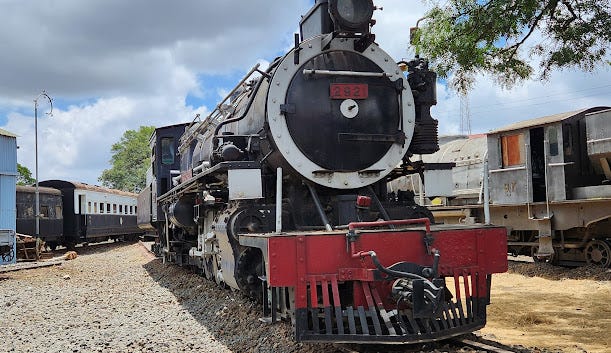The Nairobi Railway Museum is a railway museum in Nairobi, Kenya. It is located near Central Railway Station, a short walk from the city center. It was opened in 1971 by the East African Railways and Harbours Corporation and is open daily from 8:30 a.m. to 5:00 p.m. The museum showcases Kenya’s rich railway history through a collection of old steam locomotives, vintage carriages, railway tools, maps and photographs. Visitors see the famous carriage linked to the Man-Eaters of Tsavo, climb aboard historic trains and learn how the railway helped shape modern Kenya. Nairobi Railway Museum is a wonderful place for families, students and tourists to explore Kenya’s transport heritage.
History and background of the Nairobi Railway Museum
The Nairobi Railway Museum was founded by East African Railways Corporation to preserve and share the history of Kenya’s railway system. The museum was created to protect the old trains, equipment and records used during the construction and operation of the famous Kenya–Uganda Railway, known as the Lunatic Express. This railway played a major role in connecting the port city of Mombasa to interior regions and the development of Nairobi, as a small railway depot.
The museum has collected a large number of steam locomotives, carriages, tools and documents showing how railways changed trade, transport and communication in Kenya and East Africa. Today, the Nairobi Railway Museum stands as a symbol of the country’s industrial growth and a reminder of how the railway helped shape modern Kenya.
Nairobi Railway Museum entrance fee
Nairobi Railway Museum offers affordable entrance fees for all visitors. Kenyan adults pay KES 200 while children pay KES 100. For non-resident tourists, the entrance fee is KES 600 per person.
Museum entrance fee makes it easy for families, students and tourists to enjoy and learn about Kenya’s railway history. The museum is open daily, giving visitors plenty of time to explore exhibits and outdoor displays.
Activities to undertake in the Museum
Visitors visiting the Nairobi Railway Museum enjoy many interesting and educational activities, such as:
Exploring old trains and carriages
By walking through and climbing aboard vintage locomotives and carriages used during the early days of Kenya’s railway.
Touring indoor exhibits
Seeing displays of railway tools, photographs, maps and historical documents that tell the story of Kenya’s railway system.
Taking guided tours
Learning detailed information about the history of the railway and its role in Kenya’s growth.
Taking photographs
Capturing memorable pictures with old steam engines and classic carriages.
Participating in educational trips
School groups and students visit the museum to study transport and history topics.
Watching short films or presentations
Learning about famous events such as the construction of the railway and the story of “Man-Eaters of Tsavo.”
Buying souvenirs
Purchasing railway-themed items, books and postcards at the museum’s small gift shop.
Relaxing outdoors
Spending time in an open-air yard surrounded by old trains and a peaceful environment near the working railway line.
Nairobi Railway Museum is an important part of Kenya’s history, learn about how the railway helped build the nation, a chance to see old trains, explore interesting exhibits and understand the role of the railway in connecting different parts of the country. A visit to the Nairobi Railway Museum is a true celebration of Kenya’s progress and growth through the years.

